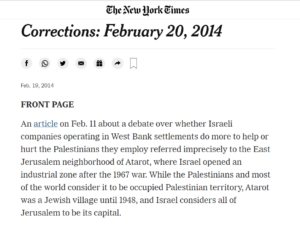A day late and many dollars short of objective journalism, a page-one Los Angeles Times news headline, Friday, Nov. 26 declared: “Old airport is one more obstacle to peace: Israel wants to build a settlement on land sought by Palestinians for a future state.”
The blatantly partisan determination — “Old airport is one more obstacle to peace” — belongs in a headline for an editorial or Op-Ed column, not a news story.
Indeed, the Associated Press, the wire service which penned the story, selected a headline, however flawed, which was exceedingly more appropriate for a news article: “Israel plans large settlement at shuttered Jerusalem airport.” (We’ll return to the misleading characterization of a Jewish neighborhood in Jerusalem on Jewish-owned land in which a Jewish village stood until it was depopulated in 1948 as a “settlement.”)
Thus, Los Angeles Times news editors actively inserted the problematic assertion into the page-one headline, upcycling views as news. While The Times’ partisan news headline stated as fact that this particular construction proposal for 9,000 housing units “is one more obstacle to piece,” AP’s article more factually and judiciously reported:
It’s one of the several settlement projects that are advancing despite condemnation of the Biden administration, which along with the Palestinians and much of the international community views the settlements as an obstacle to resolving the century-old conflict.
In other words, the notion that the 9,000 Jewish homes in Jerusalem are an obstacle to peace is a view — an opinion — not a fact.
Moreover, it’s not that every setback in the region — perceived or real, theoretical or actual — warrants a page-one Los Angeles Times news headline bemoaning “one more obstacle to peace.”

Not “one more obstacle to peace.” The Los Angeles Times did not report one word about the murder of Eli Kay (Photo from Facebook)
While The Los Angeles Times deemed as-yet-to-be-approved plans for building more Jewish homes in a disputed part of Jerusalem as an “obstacle to peace” worthy of a page-one headline accompanying an article of more than 1,000 words, the actual murder last week of an Israeli civilian in the same city did not warrant any Times attention whatsoever. Indeed, the murder of Eli Kay, 26, of Modiin, at the hands of a Palestinian terrorist Monday in Jerusalem’s Old City did not get one word of coverage in The Los Angeles Times, much less a page-one headline about “one more obstacle to peace.”
Another significant development last week which garnered not a single word in The Los Angeles Times, let alone a front-page headline about “one more obstacle to peace,” was the arrest of more than 50 Hamas terrorists in advanced stages of planning massive terror attacks, including suicide bombings with widespread carnage like those of the bloody second Intifada.
Thus, in the eyes of The Los Angeles Times, Israeli plans to advance the building of 9000 homes in Jerusalem are an “obstacle to peace” of the first order, demanding a page-one, 1,000 word story. The actual murder of an Israeli citizen and the arrest of dozens of terrorists with the plans and the means to inflict mass casualties is not a story at all.
But The Times’ failure is actually worse than that. It’s not just that the Israeli construction plans had not yet been approved and were in a very early stage of discussion which would take years to materialize. (As the article reports: “An Israeli government official said the project is in the early planning stages, and that it will probably be years before it comes up for government approval.”) By the time the article appeared on The Los Angeles Times Nov. 26 front-page, Israel completely shelved the plans.
The Los Angeles Times Nov. 26 page-one story about Israeli plans for the building of Jewish homes over the Green Line in Jerusalem – a plan years away from government approval – was published two days earlier by the Associated Press, on Nov. 24. By the next day, Nov. 25, one day before The Times’ sensational, editorializing headline appeared, the Associated Press published another article making clear that Israel put the already remote plans into deep freeze.
“Rights group: Israel puts Jerusalem settlement plan on hold” was Joseph Krauss’ Associated Press follow up story one day before The Times ran the lengthy and outdated article about the supposed advancement of the very same plans.
One day prior to The Times’ story about the Israeli construction plans, AP had already reported:
Israeli authorities appear to have put plans to build a large Jewish settlement at an abandoned airport in east Jerusalem on hold, at least for now, a rights group said Thursday. . . .
Hagit Ofran of the Israeli anti-settlement group Peace Now said a district planning committee meeting at which the project was expected to be approved has been cancelled, meaning “the plan is off the table for now.”
Los Angeles Times editors had access to AP’s Nov. 24 article about the advancement of the plans, which means they also had access to the wire service’s Nov. 25 article about the plans going on hold. And yet the paper’s foreign desk still selected the outdated story for Friday’s front page.
Atarot: A Jewish Village Pre-1948
While The Los Angeles Times subjected AP’s material to great abuse, the wire’s coverage by Joseph Krauss was itself significantly flawed. In particular, the long article about Atarot, which topped 1,000 words, failed to note the relevant information that prior to 1948, a Jewish village stood at the site in question. “Since the early 1900s, even before the first World War, the neighborhood was owned by Jews, who purchased, settled and worked the land,” as CAMERA’s Gilead Ini previously reported. Jewish life there came to an abrupt end in 1948 with Jordan’s occupation which lasted until 1967. Jewish owners were forced out under fire and their homes were razed by Arab invaders, Ini noted.
 As the CAMERA-prompted New York Times correction acknowledged in 2014:
As the CAMERA-prompted New York Times correction acknowledged in 2014:
An article on Feb. 11 about a debate over whether Israeli companies operating in West Bank settlements do more to help or hurt the Palestinians they employ referred imprecisely to the East Jerusalem neighborhood of Atarot, where Israel opened an industrial zone after the 1967 war. While the Palestinians and most of the world consider it to be occupied Palestinian territory, Atarot was a Jewish village until 1948, and Israel considers all of Jerusalem to be its capital.
Krauss’ truncated pre-1948 history of Atarot omitted mention of the Jewish land ownership, village and subsequent dispossession:
The British built a military airfield in the early 1920s, when Jerusalem was the administrative capital for the Palestine Mandate. Jordan captured the site along with the rest of east Jerusalem and the West Bank in the 1948 war surrounding Israel’s creation and transformed it into a civilian airport catering to religious pilgrims and other travelers.
In a separate historical deception, the AP reported:
Khalil Tufakji, a Palestinian cartographer and former peace negotiator focused on Jerusalem issues, said the new settlement is part of a larger process of pushing Palestinians out of the city and bringing in Jewish residents in order to change its character and prevent any future partition.
“It’s fundamental demographic change in favor of Israel.”
Tufakji’s unchallenged assertion that the city is becoming increasingly Jewish is completely unfounded. Contrary to Krauss’ reporting, since the city’s 1967 unification under Israel, Jerusalem has become more Arab and less Jewish. In 1972, for example, Jerusalem was 26.6 percent Arabic and 73.4 percent Jewish. By 2019, the city’s Arab population climbed to 38 percent, and the Jewish percentage declined to 62 percent.
In short, readers combing The Los Angeles Times to become informed on Israeli-Palestinian events and history are ploughing the sands.

